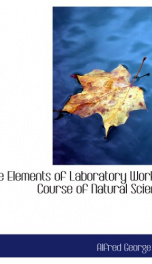the elements of laboratory work a course of natural science

PREFACE THE course of work described in the following pages forms an introduction to all branches of Natural Science. The ele- mentary nature of the book has caused me to pay more attention to method than to detail. Every student will need to follow closely and thoughtfully the performance of each ex- periment, in nearly all cases making his own observations and measurements, in order that the capacity for independent judgment, as well as an interest in original research, may be awakened at the outset. When a fact or law, discovered by means of a students own personal observation and intelligence, turns out to be very familiar to others more advanced, the value of the research to the student himself is but slightly impaired. Each section conveys a definite lesson, and care has been taken that they may follow in inductive sequence. It is im- portant that each experiment and each stage of the course be described and reviewed at length in the students note- book, which should contain many practical details omitted from the text-book, not only lest they should obscure the . over-help, more important outlines of work, but also because it is in- tended that some freedom and originality in manipulation should be encouraged. The trials and practical difficulties of the laboratory are too valuable educationally to be set aside by though it is essential that they should not be too severe. Itmay be noticed that while tables are added to show the results of accurate observers, and to give information as to relative magnitudes, the numerical values resulting from the selected experiments have been generally left to be worked out by the students themselves from their own observations. The word speed has been used to denote the rate of motion of a particle along its path, in preference to the term velocity, which is now generally reserved to designate a quantity having both magnitude and direction, i.e. a vector. The sections numbered 3, 7, 12, 13, 14, 15, 24, 25, and 26, together with many of the additional exercises, may be omitted by be- ginners. Rooms devoted to practical science, and well equipped, are nowadays considered a necessary part of all public schools and colleges, and this book is simply intended to be used as a handbook in such laboratories. An effort has been made to arrange a practical and progressive course which shall touch upon the chief problems, and point out the main lines of investigation in Natural Science, in preference to an attempt at explaining any one branch in detail. It is also hoped that the course may give some training in that habit of directly appealing to nature, rather than to theories, which is the root of all scientific progress, although unfortunately it is not always made the basis of scientific education, partly from want of time and partly from want of appliances. TONBBIDQE 1890. A. G. EARL. CONTENTS CHAPTER I MEASUREMENT OF QUANTITY OF MATTER PJIGB 1. To find equal quantities of matter 1 2. To compare two quantities of matter...... 2 3. To test the accuracy of a set of weights by the balance . . 3 4. To investigate the construction of an accurate balance . . 3 Additional exercises and questions . . . . .4 5. Measurement of length and volume 5 Additional exercises and questions ...... 6 6. Relative quantities of matter in equal volumes of different substances .7 Additional exercises and questions 7. Principles of systematic measurement ..... 8 8... --This text refers to an alternate Paperback edition.
Info about the book
Author:
Series:
Unknown
ASIN:
B003U6XXY6
Rating:
5/5 (5)Your rating:
0/5
Languge:
English
Users who have this book
Users who want this book
What readers are saying
What do you think? Write your own comment on this book!
write a commentif you like the elements of laboratory work a course of natural science try:
Do you want to exchange books? It’s EASY!
Get registered and find other users who want to give their favourite books to good hands!


